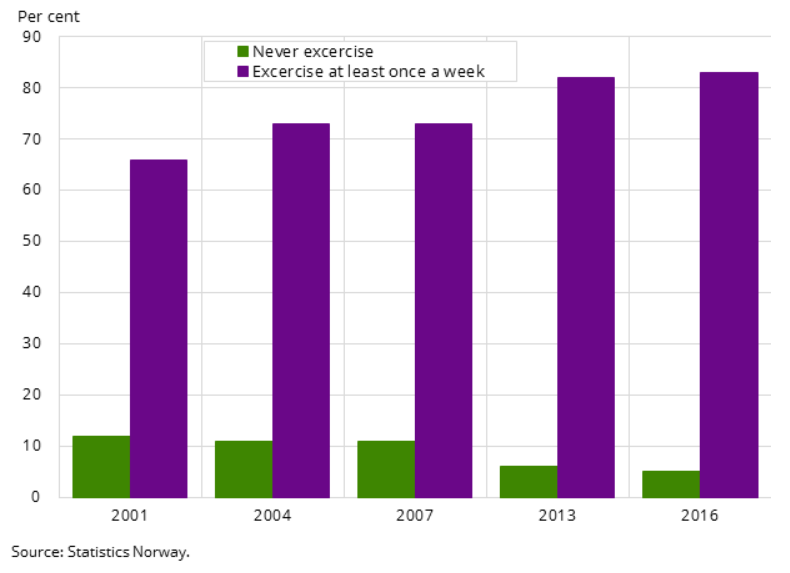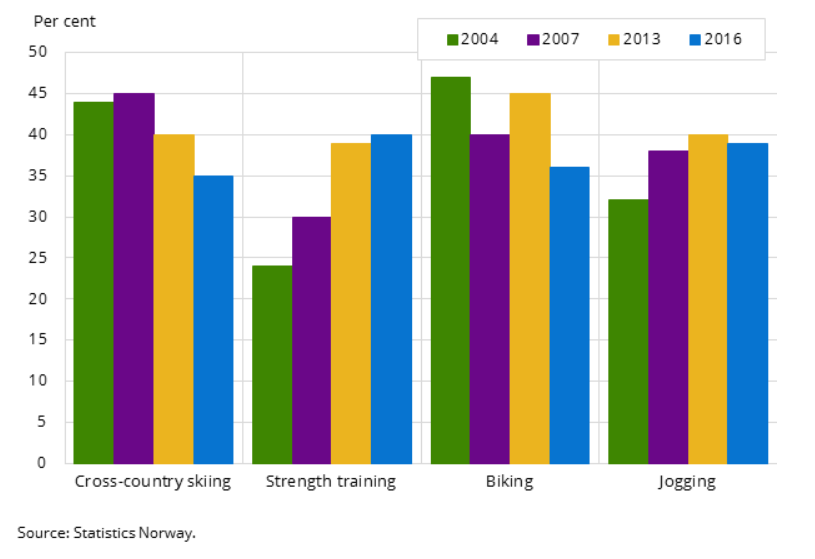Physical activity (PA) prevalence seemed to be increasing in Sweden according to two national surveys: National Public Health Survey – Health on Equal Terms (HLV) and Survey of Income and Living Conditions (SILC) (1,2). Currently, around 67 % of people seemed to be meeting the PA guidelines; more than 150 minutes of moderate-intensity PA per week, and around 75 % of people seemed to be doing outdoor or indoor sports for more than 20 minutes per week.
I found this trend quite good but wonder how it is relative to other countries. For example, I often hear that people in Norway are more active than Swedes. Apparently, Norwegians are so active, especially in cross-country skiing. Some Swedes even say that almost all Norwegians are doing cross-country skiing. I know that that is an exaggeration but made me wonder if PA prevalence is actually higher in Norway than in Sweden, and thought that the comparison would help understand the PA prevalence in Sweden better.
A good start for an international comparison of PA was at the Global Physical Activity Observatory (GoPA) where PA prevalence and other relevant information are summarized by each country. According to the GoPA’s country cards (3);
PA prevalence in Sweden: 67 %
PA prevalence in Norway: 66 %
*For additional information;
(PA prevalence in Japan: 65 %)
(PA prevalence in the US: 68 %)
Not pretty much difference across these high-income countries. However, the prevalence level reported in these country cards is put more focus on international comparisons. Therefore, comparable survey methods are prioritized over national-specific surveys. For example, PA prevalence in Sweden and Japan is derived from relatively small sample surveys using the global physical activity questionnaire (GPAQ) (4).
To make further comparisons between PA levels in Sweden and Norway, I looked into a Norwegian national survey that can be equivalent to a Swedish survey of public health (HLV) or living conditions (SILC). According to the National Survey in Norway, more than 80 % of people exercise at least once a week as of 2016 (5).

In addition, the prevalence seems to be increasing since 2001. In contrast, the prevalence of people who never exercise is decreasing and that became only 5 % as of 2016. Another interesting data is by types of activities in which people participated.

As I have heard, cross-country skiing seems popular; close to half of people were doing it in 2004. However, an interesting increasing trend of strength training can be seen over time while cross-country skiing is gradually decreasing.
There was no directly comparable data to the PA level of Sweden though, a few things got clear. Norwegian people seem to be quite active. More than 80 % of people exercise at least once a week. Even though the intensity and duration of exercise are uncertain, I can understand how Swedish people insist that Norwegians are so active. Only 5 % of people responded that they never exercise in a week in 2016. However, it is difficult to conclude if Norwegians are more active than Swedes based on these data. Perhaps, the intuitions of residents are more reliable. I should probably stay in Norway and conduct field observations. Besides, it may be helpful to look into the weight status of the Norwegian population relative to Swedes as that is closely linked to PA.
References
1. Folkhälsomyndigheten. Nationella folkhälsoenkäten – Hälsa på lika villkor [Internet]. 2023 [cited 2023 Jul 19]. Available from: https://www.folkhalsomyndigheten.se/folkhalsorapportering-statistik/om-vara-datainsamlingar/nationella-folkhalsoenkaten/
2. Statistics Sweden. Statistics on Income and Living Conditions [Internet]. Statistics Sweden; 2022 Oct [cited 2023 Apr 12]. Available from: https://www.scb.se/en/finding-statistics/statistics-by-subject-area/living-conditions/living-conditions/living-conditions-surveys-ulfsilc/#_Moreinformation
3. Global Observatory for Physical Activity. Country Cards [Internet]. 2020 [cited 2023 Jul 18]. Available from: https://new.globalphysicalactivityobservatory.com/card/?country=SE
4. Guthold R, Stevens GA, Riley LM, Bull FC. Worldwide trends in insufficient physical activity from 2001 to 2016: a pooled analysis of 358 population-based surveys with 1·9 million participants. Lancet Glob Health. 2018 Oct 1;6(10):e1077–86.
5. Statistics Norway. ssb.no. 2016 [cited 2023 Jul 28]. Norwegians exercise more than before. Available from: https://www.ssb.no/en/kultur-og-fritid/artikler-og-publikasjoner/norwegians-exercise-more-than-before
